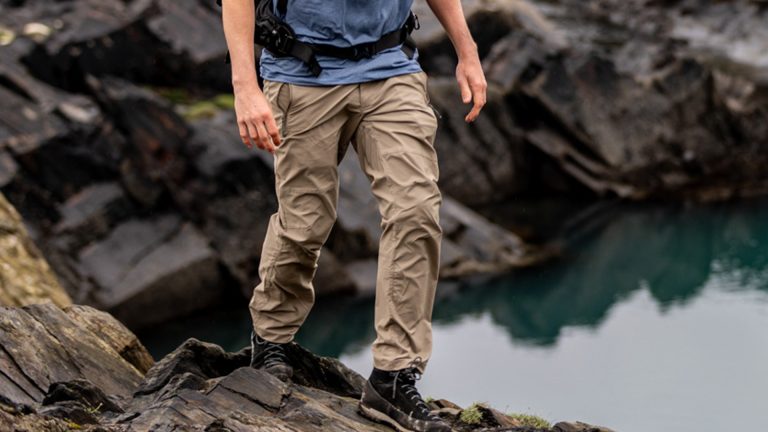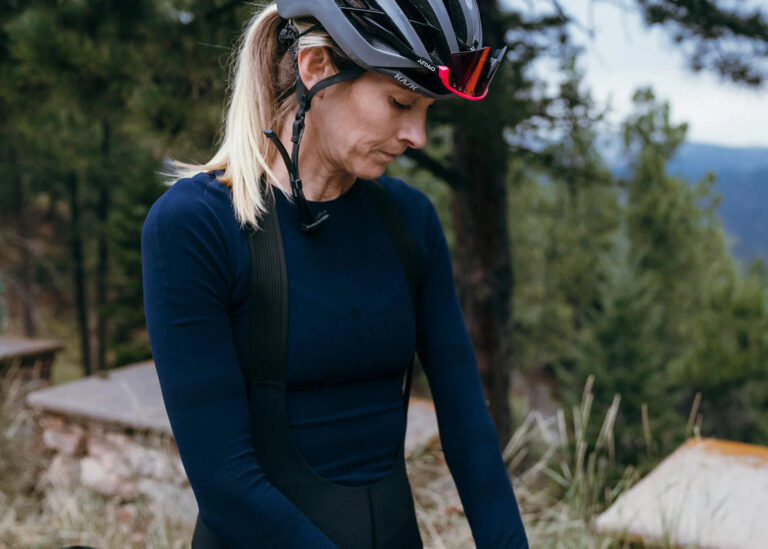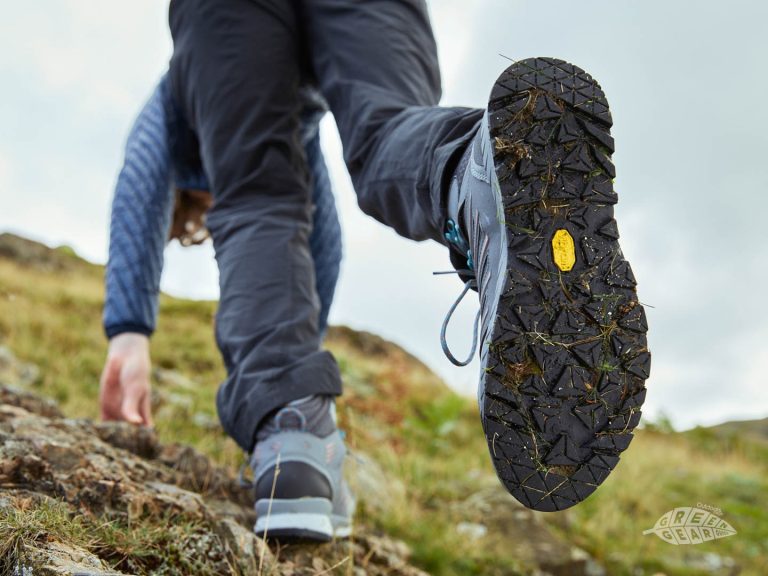Camping – there’s
not a lot to it really is there? A tent, a sleeping bag and something
to cook on, how hard can it get? Well if you base your idea of camping
on what you see on an average camp site you’ll be forgiven for thinking
it rquires a couple of metric tons of added extras to make life under
canvas (does anyone actually use canvas any more?) manageable. Away
from the multitude of regulated campsites, if you look carefully,
you’ll find a growing band of people for who the wilderness experience
offers more by camping beyond the sight of roads and habitation.
Wild camping – What is it?
To put it simply wild camping is simply camping without the facilities
of an organised site. To the majority of wild campers it’s more than
this – it’s a way of getting closer to the wilderness and nature,
surviving with just what you can carry in (and out again). You won’t
have showers, shops or an on-site pub, but in return for carrying your
shelter with you there’s the bonus of peace and solitude and
the chance to take in sunrise or sunset like never before.
Of course you’re not going to be able to carry folding kitchens and
multi-room family tents, even if you could find a piece of land big
enough to pitch one on, so there’s a few compromises you’ll need to
make on kit. Depending on which side of the Anglo-Scottish border
you’re on you couldalso find a raft of regulations limiting where and
when you can camp freely.
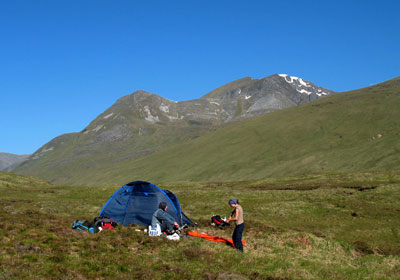
Start your walk half way up – Wild camping in Glen Nevis by Richard Sun
but how do I get started?
The first rule about wild camping is you have to carry everything in,
and back out again, so you’ll need to take a careful look at your kit.
When you’re carrying everything on your back every Kilo counts, and if
you get bitten by the wild camping bug you’ll soon be counting
individual grams. This doesn’t mean you have to join the “Lightweight
Brigade” and invest hundreds of pounds though – you can start off slow
and trim your kit bit by bit over time.
Equipment
Most people start out camping by car, where it doesn’t really matter
much what everything weighs as long as there’s room in the boot – but
with a little compromise you can use the majority of this kit in your
early forays into the world of wild camping. Start off by cutting out
the things you won’t need – chairs, tables and electrical appliances,
then move onto your essential items and look at where you can shed bulk
and weight. It may sound obvious, but you’re not really going to want
to carry bags of spuds and cans of food around the hills all day, and
you really don’t want to be lugging a multiburner stove and grill
strapped to your pack – but cutting down doesn’t have to break the
bank. The chances are you first few trips are going to be one nighters,
and fairly close to civilisation, so you don’t need to go overboard
with buying the lightest of everything – cans can be decanted into
ziplock bags and a small camping stove and gas canister needn’t set you
back more than £15.
Tents
If you’re camping out of your car then you can quite happily blow
caution to the wind when it comes to weight. But it’s obviously a
different story if you’re backpacking: weight matters. If you take a
look at the latest catalogues it won’t take long to
notice that less is definitely more when it comes to paying for weight.
The latest ultralight tents and rucsacks come with a hefty price tag
for the privilige of carrying less – a top end solo tent can easily set
you back in excess of £250. When you’re looking around for
lightweight tents, bear in mind that that the manufacturer’s quoted
useable weight is often much less than the actual weight of the tent as
they’ll only use the minimum number of poles and will discard bags and
guys etc. Around 2.5 to 3 kilos should be your ballpark figure for a
two-man tent, and 1 to 1.5 kilos for a solo. Unless you’re planning on
starting out with a winter in Scotland you’ll find the majority of
three season tents are more than up to the job – and your average tent
can even bring advantages with extra room and a more substantial
groundsheet the trade off for the extra weight.
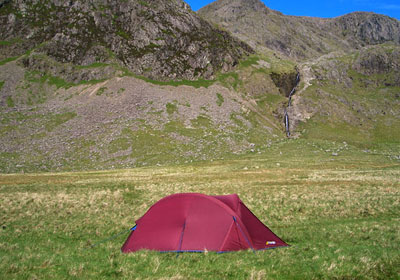
You don’t need the latest megabucks ultralight to get away from the
crowds
designed for the lightweight traveller that are ideal for the wild
camper. The classic Hilleberg
Akto still holds a special place
in the wild camper’s hearts with it’s combination of high stability,
simplicity and a 1.5k trail weight. Over the last few years, more and
more manufacturers have jumped on the lightweight bandwagon, with new
claims for the “World’s lightest tent” coming year after year. The
leading contenders in the lightweight race are Terra Nova’s Laser
family, with the a choice of one and two man tents from less than a
kilo per person. The Laser
Competition, designed for the
mountain marathon devotee weighs in at a stunning 0.94k – that’s less
than a litre of water, while for the wild camping couple there’s the
new Laser
Space 2 which combines
lightweight fabrics and poles to create a 2.77k option that offers room
to cook in the porch with enough height to sit up in comfort.
For the real enthusiast the solo bivvy offers an option of “sleep
anywhere” with tiny footprints you can fit on a ledge or behind a wall.
Surprisingly the bivvy option isn’t going to save you much in terms of
weight, with favourites like the Terra
Nova Jupiter coming in at around
the 1 kilo mark.Where the bivvy scores over the lightweight tent is in
the choice of site for the night – if there’s room to lie down there’s
room for a bivvy, and even a hooped bivi will go up in less than 2
minutes. Non hooped bivvys, like the Rab
Survival Zone, have their place
in the wild camping scene too though these are often combined with a
tarp as a bad weather option. Tarps are popular in the warmer, more
settled, climates of the USA and have been making an impression on the
UK market over the last few years and combined with a Survival Zone or Alpkit
Hunka can bring the total wight
down to around half a kilo.
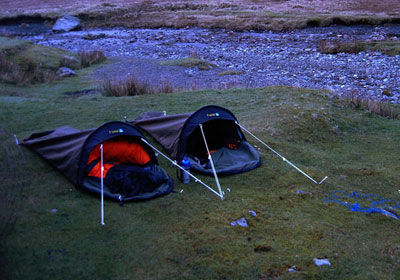
With a bivvy you can pitch anywhere
Even pitching late and striking early you’re going to be spending a
third of your time in your sleeping bag, so selection is important.
Down sleeping bags usually have a better warmth to weight ratio than
their synthetic counterparts – so long as you don’t get them damp.
Performance varies according to the quality and fill power of the down
– the higher the fill power, the warmer it is. An average synthetic bag
is going to weigh in at around 1.5 to 2 kilos and an average down bag 1
to 1.5 kilos. Sleeping bags, especially the higher end, are expensive
investments so when starting out you’re probably better off
sticking with what you’ve already got till you’re sure what
you want. Synthetic bags don’t usually give as much warmth per gram as
a down bag but they do the job in a range of conditions, including damp
ones. Buying a bag is a play-off between weight, temperature rating,
and the contents of your wallet. For a good entry level synthetic bag
suitable for 2 or 3 season use the Snugpak range offer value for money
while keeping the weight as low as possible – the Snugpak
Softie 3 weighs in at 750gm with
a 5C rating and the Snugpak
Softie 9 offers protection to
-5C though at double the weight.
The down bag market has traditionally been dominated by a few big
names, Mountain Equipment and Rab leading the way, but increasingly
smaller, independent manufacturers are making an impact. At the entry
level point Alpkit have created a range of high insulation, low cost
bags, with the Pipedream
400 offering good 3 season
useability down to -3C and only weighing 0.77 kilo. At the top end of
the market you’ll be pay more, with the OMM
Q700 offering similar levels of
insulation at around twice the price of an Alpkit. PhD Designs also
offer specialist bags, either from stock or custom designed, and are
famous for their low weight – high quality down bags like the Minim
400 at a miserly 670gm.
No matter how good your sleeping bag is you’ll need someform of
insulation underneath it. Mountain marathoners and adventure racers may
use bubble wrap or similar as a lightweight soloution but the reality
is they’re not really going to do the job on a regular basis the way a
purpose designed product will. Starting out a standard roll mat,
available pretty much anywhere at low cost, will do the job but as with
tents and sleeping bags there’s options to lose grams while adding
pounds to your kit cost. Self inflating mats are a popular option and
come in a range from heavy, down insulated, models to lightweight
torso-only options. The Therm-a- rest mats from Sierra Designs are well
respected, with options like the Prolite
4 Short giving a good compromise
bewteen weight (482gm) and 4 season insulation. For the real
gram saver you can always cut down a Therm-a-rest Z Lite to cover just
the torso and only carry 219gm.
Food and cooking
While a big multi-burner stove and canned food may offer a full ramge
of cooking options when you can transport everything by car you really
wouldn’t want to carry it all up into the hills. The solution to
cooking in the wild is quite simple, single burner stoves and
lightweight food. An entry level stove is only going to set you back
£10 -£15if you shop around for a simple
solution using standard resealable gas canisters, with the Coleman
F1 Lite a good example. The MSR
Pocket Rocket has a well
respected reputation, offering high output and reliability for just a
few grams more than the Coleman.
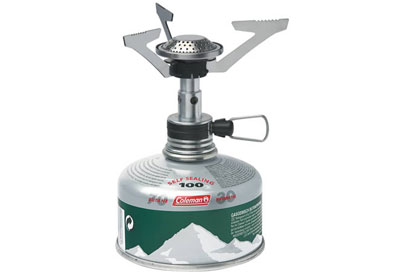
F1 Lite – an entry level stove that still counts the grams
using alternative fuels like meths and gels. The Jetboil
PCS made a massive impact when
it hit the market back in 2005, giving fast boil times combined with
groundbreaking fuel effeciency, and this has been followed up with the
latest Primus
EtapackLite which takes fuel
efficiency of 80% – the less fuel a stove uses the less you have to
carry. Real wild camp enthusiasts take this gas saving to new limits by
only bringing food and liquids to the boil then covering the cooking
pot with an insulating cover made from thermal reflective materials to
complete the cooking process. Over the last few years, fuelled by a
healthy USA based cottage industry, there’s been an increasing move
towards using meths burners in home made “Coke Can” style stoves –
these offer cheap (or free), ultralight options that take up minimal
pack space and flexibility of fuels with a choice of meths or alcohol
based gels.
In terms of food most people have seen the dehydrated packs widely
available in outdoor stores, and these are more than adequate for the
average wild camper – but by no means essential. Using ziplock bags,
boil in the bag bags and nalgene bottles it’s an easy enough job to
take real food with you, and although they may weigh a few grams extra
it’s a one way carry as you won’t be carrying them out full. In the
long term you can dehydrate your own food if the bug really takes hold,
and benefit from eating your own favourite home cooked meals in the
hills.
Wild camping and the Law
It would be great if you could just put up a tent wherever you like for
the night, but not surprisingly there’s a raft of restrcitions on when
and where you can set up camp for the night at will. The most important
factor is which side of the border you’re on, with the law in Scotland
radically different to those covering England and Wales. In short wild
camping in Scotland is a right, whereas in the rest of the UK there is
no automatic right without express permission from the relevant
landowner.
The
Land Reform (Scotland) Act 2003,
which came into force in February 2005 sets out the rights of
access and the right to camp throughout the whole of Scotland. The Act
established a legal right to camp (when done by a person in the
exercise of the access rights created by the Land Reform Act) and
details the responsibilities and guidelines to be followed. The
Code provides specific advice on wild camping and recommends that in
order to avoid causing problems you should not camp in enclosed fields
of crops or farm animals. Access rights extend to wild camping. This
type of camping is lightweight, done in small numbers and only for two
or three nights in any one place. You can camp in this way wherever
access rights apply but help to avoid causing problems for local people
and land managers by not camping in enclosed fields of crops or farm
animals and by keeping well away from buildings, roads or historic
structures. Take extra care to avoid disturbing deer stalking or grouse
shooting. If you wish to camp close to a house or building, seek the
owner’s permission.
In England and Wales the position is entirely different, with no such
right to camp – even on on land opened up by the CRoW legislation. In
short you need the express permission of the landowner to camp anywhere
in England and Wales, though there are certain areas where wild camping
is accepted providing reasonable precautions are taken. In the Lake
District and Snowdonia there are wide areas where the practice is
accepted providing you’re out of sight of all roads and human
habitation, but it’s always worth bearing in mind it’s not a right, but
a privilige granted by the landowners. Camp high up, pitch late and
strike camp early are the general rules, along with leaving no trace of
having been there.
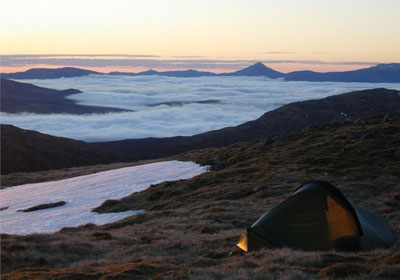
Terra Nova Laser on Rannoch Moor by PTC
Although designed for Scotland the MCoS
have published a very useful and easy to follow guide of best practice,
and one which should be followed whether in Scotland, England or Wales.
The essentials are:
- Keep group sizes small
- Camp as unobtrusively as
possible and away from popular spots which become overused - Leave no trace of your
having been there - Remember noise travels
fromtents and may disturb wildlife - vegetation becomes more
sensitive as you gain altitude - Lighting fires on peaty
soils and dry grass pose a major fire risk - Take extra care when camping
near water courses not to pollute the water - Remove all food and waste
scraps – they can attract scavengers and put other species at risk - Never go to the toilet
within 30 metres of frsh or running water, and always carry out waste
where possible. - If carrying out waste is
impossible ensure it is buried at least 15 cm below ground and covered
– do not bury used toilet paper. - Carry out all rubbish, even
other people’s.
And Finally…….
Wild camping is fun, and a great way of experiencing nature first hand.
Don’t be worried about starting out, start off with a short trip in a
familiar area where if it all gets a bit too much you can quickly pack
up and retreat. Despite the advice in the code above there’s a few
popular and well used spots that make good starting points. Angle Tarn
and Sprinkling Tarn in the lake District provide all the essentials of
a good location – unobtrusive, readily available water (remember to
take a water filter and/or boil all water), well protected from the
elements and a short walk in.
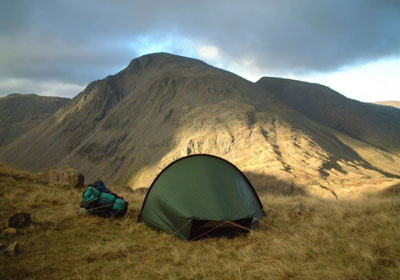
Wild camp in Borrowdale by Peewiglet


